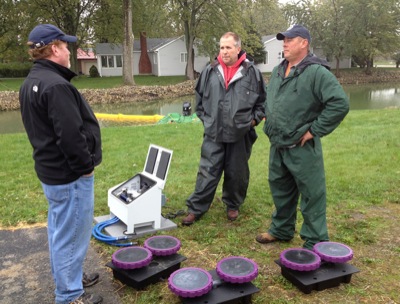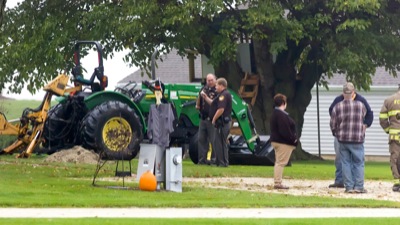Wednesday, October 3rd, 2012
New water restoration test begins
By Nancy Allen

Submitted Photo
A company began testing technology that uses aeration and microbes in a channel at Otterbein Retirement Community on Grand Lake on Tuesday. Pete Kennedy, left, of Organic Ponds, Bill Rohr, dredge operator at Grand Lake St. Marys State Park, and Tom Grabow, dredge supervisor, discuss the air stations that will be placed in the bottom of the channel. The white box contains the air compressor that will deliver air to the stations.
GRAND LAKE - Another pilot started Tuesday on Grand Lake, this one using aeration and natural microbes to reduce sediment and improve water quality.
The test is being conducted in a channel at Otterbein Senior Lifestyle Choices by Organic Pond, a Fraser, Mich.-based company.
No local funds are being used to do the test, Milt Miller, manager of the Lake Restoration Commission, said.
Two test areas totaling an acre have been set up in the channel. The first area is closed off from the lake with a curtain; the second is open to the lake.
Three weighted air stations that emit tiny air bubbles have been sunk in each of the test areas, Jeff Kennedy of Organic Pond said. The aeration energizes existing bacteria in the water to start the natural cleaning process and then additional bacteria sprayed into the water speeds it up.
The entire system costs about $7,000.
"The cool thing about the bacteria is they are naturally occurring, nonpathogenic bacteria whose sole purpose is to consume excess nutrients typically found in a pond or lake such as phosphorous runoff, fish waste, decaying algae and weeds, all organic substances on the bottom," Kennedy said.
The company originally produced the bacteria for use by fish farmers and now markets it to restore water bodies with low dissolved oxygen levels, algae and other water quality problems. The largest body of water the company has treated is a 160-acre natural lake in Michigan, which had nearly 5 feet of muck on the bottom. Within three years, the muck was reduced to about a foot, Kennedy said.
"We use bottom diffused aeration combined with microbes, basically beneficial bacteria to restore the health of water," he said. "We've done small ponds to fairly large lakes, but nothing to the scope of Grand Lake, but the principle still applies."
Kennedy said he remembers visiting Grand Lake as a kid with his family from Dayton. A fish grower from southeast Ohio recently made Kennedy aware of the lake's plight, he said.
The air stations will stay in the channel for two to three months while MAD Scientist & Associates, Westerville, gathers water data to produce a report in December to determine its effectiveness.
The 13,500-acre Grand Lake has been under state water advisories the past four summers due to toxic blue-green algae blooms. The algae's main food source is phosphorous, most of which runs off farmland, the largest land use in the 58,000-acre watershed.
Kennedy said his company also is working with farmers in the lake watershed to determine if the microbes can be used in manure to reduce the amount of solids and on farm fields to allow crops to better use existing phosphorous in the soil.
Miller said this is another technology that might help lessen algae blooms and improve water quality in channels.
"We know aeration works; now it's just a matter of testing different delivery systems for matters of economics and what works best," Miller said.
Kennedy's company also has proposed harvesting rough fish from the lake. Studies show that rough fish such as carp, shad and quillback suckers negatively impact water quality. Some state officials estimate that by weight 90 percent of Grand Lake's fish population is rough fish.
"What we are proposing to do and working with ODNR on is to do a major harvest which would take years," Kennedy said. "We would harvest these fish live and market them to markets in China and Europe where, surprisingly, carp is a delicacy."
Lake reports:
Alum application
The state does not know when a report will be completed showing the effectiveness of the April alum treatment to the 4,900-acre center of Grand Lake. Chris Abbruzzese, a spokesman with the Ohio Department of Natural Resources, said consultant TetraTech is still compiling the report. Last year's alum application reduced phosphorous levels in the center by up to 56 percent and 20-30 percent in untreated areas.
Alum deactivates phosphorous, the main food source of the lake's toxic, blue-green algae. The state spent $8.4 million for the treatments this year and in 2011. Originally, the state said the report would be done in September.
Kria ionizer
A report showing whether a Kria ionizer can kill the lake's blue-green algae is expected in mid-November, said Mark Dilley of MAD Scientist & Associates, Westerville, the company compiling the report. The unit was installed Aug. 22 near the Celina Water Treatment Plant intake pipe off U.S. 127. The report was scheduled to be completed this month but was delayed due to mechanical issues with the unit, he said.
The ionizer negatively charges oxygen molecules and injects them into the water at a very high rate of speed, disintegrating the algae, said Mike Mangham of Eco USA, the importer of the Japanese-made unit. The ionizer also adds oxygen to the water, causing beneficial bacteria in the sediment to grow and eat organic material such as algae, pesticide and fertilizer. No local money is being spent on the test or report.
Airy Gator
A report on the effectiveness of an giant aeration unit called an Airy Gator also is due in mid-November, Dilley said. The testing of the unit began Aug. 22 off the shore of the lake at the St. Marys Boat Club.
This is the second Airy Gator that has been tested in the lake. A report on the first Airy Gator test in 2010 at Southmoor Shores showed it improved water quality but said the unit must be used in conjunction with other efforts to make any measurable improvement.
Dilley said the second test is being conducted in a more open area of the lake to see if the original positive results can be replicated.
Bottom diffused aeration
A report on the effectiveness of using aeration and microbes to consume organic material in the lake sediment is expected in December. The test began Tuesday in a channel at Otterbein Retirement Community. The process does two things: aeration energizes existing bacteria in the water that starts a natural cleaning process and then additional bacteria sprayed into the water speeds up the cleaning process.
No local money is being spent on the test.
Correction:
Chris Abbruzzese is a spokesman with the Ohio Environmental Protection Agency, not the Ohio Department of Natural Resources. The error was made in reporting.





